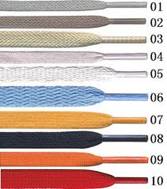 Gentlemen, look at your shoes. Are they lace-ups? If so, are the laces the original laces the shoes came with, or did you replace them? Shoelaces don’t seem to be significant enough to spend time or brain cells worrying about, but, no surprise, I’m here to tell you they are!
Gentlemen, look at your shoes. Are they lace-ups? If so, are the laces the original laces the shoes came with, or did you replace them? Shoelaces don’t seem to be significant enough to spend time or brain cells worrying about, but, no surprise, I’m here to tell you they are!
Two skinny strands of fabric or leather; subtle shoelaces have the capability of making or breaking an outfit. Sounds crazy, since who bothers to notice shoelaces? Normally, no one… unless they’re in bad condition or are the incorrect laces for the shoes, and then they standout like a flashing, neon green light for everyone to see.
It’s pretty safe to rely on manufacturers to couple shoes with compatible shoelaces, so unless you want to switch them out to add your own personal flair, there’s no need to be concerned about styles or colors matching. However, if it’s time to replace the laces, there are a few rules to follow, which will keep you on top of your fashion game.
Shoelaces come in a multitude of colors, styles, materials, and lengths. It’s surprising to see just how many options are available, and how much shoelace information is online. I saw one site that offered 2000 different laces www.shoelacesexpress.com and countless sites on “everything shoelace”. Even I was impressed. However, the following information is basic and straightforward, in order to keep the task of buying appropriate shoelaces simple. So, let’s tie this up and get down to business.
Materials
Shoelaces come in an assortment of materials, ranging from cotton and leather to various synthetic fibers. Cotton shoelaces are still the most commonly used, although many specialty shoes and boots come with other, specific types of material that serve the shoe’s purpose. An example is Kevlar, which offers strength, fire resistance, and durability to boot laces for maximum wear and protection. Some other popular shoelace materials are nylon, polyesters, hemp, and polypropylene, whose use is normally determined by the type shoe or boot. The hard, round plastic end of the shoelace, known as the aglet, is typically clear plastic, although some laces offer metal.
Styles
 Basically, there are two styles of shoelaces: round and ribbon. Round are often found in dress shoes, and certain types of boots and athletic shoes. Material varies depending on the shoe’s purpose. Many dress shoes come with round leather or wax-coated cotton laces, which give formal shoes an added touch of style and sophistication. Most round laces, particularly those found in boots and athletic shoes, have cores that give them additional strength.
Basically, there are two styles of shoelaces: round and ribbon. Round are often found in dress shoes, and certain types of boots and athletic shoes. Material varies depending on the shoe’s purpose. Many dress shoes come with round leather or wax-coated cotton laces, which give formal shoes an added touch of style and sophistication. Most round laces, particularly those found in boots and athletic shoes, have cores that give them additional strength.
 The ribbon shoestring is your everyday type of lace that most of us learned how to tie shoes with. Once only found in black, brown, and white, these laces can be found in every color of the rainbow and then some. Like a ribbon, these laces are flat and still made of cotton, but are available in synthetics, as well. These are found in most shoes and boots, from sneakers to hiking boots. Not only are these typically less expensive than rounds, they tend to hold their tie better, since they don’t slip as easily. Another characteristic is elasticity, making them advantageous for active footwear.
The ribbon shoestring is your everyday type of lace that most of us learned how to tie shoes with. Once only found in black, brown, and white, these laces can be found in every color of the rainbow and then some. Like a ribbon, these laces are flat and still made of cotton, but are available in synthetics, as well. These are found in most shoes and boots, from sneakers to hiking boots. Not only are these typically less expensive than rounds, they tend to hold their tie better, since they don’t slip as easily. Another characteristic is elasticity, making them advantageous for active footwear.
Lengths
Shoelaces come in an assortment of lengths nowadays. Rightfully so, since they have to accommodate the countless styles of footwear on the market. It’s essential that shoes are laced with the appropriate length shoestring, so that they “fit” and look correct. Nothing’s worse than seeing shoes only partially laced up with a short lace, or those long, double-knotted laces that hang off the shoe and drag on the floor. Talk about an image killer!
Check out the following size charts, based on shoe style and number of eyelets or holes, to take the guesswork out of buying the correct laces. If charts aren’t your thing, grab a ruler and measure the old lace (hopefully, it isn’t broken) before heading to the store.
Dress Shoelace Lengths
|
Hole Pairs |
Shoelace Length |
|
1 – 2 |
21 Inches |
|
2 – 3 |
24 Inches |
|
3 |
27 Inches |
|
3 – 4 |
30 Inches |
|
4 – 5 |
36 Inches |
|
5 |
40 Inches |
|
5 – 6 |
45 Inches |
|
6 – 7 |
54 Inches |
|
7 – 8 |
63 Inches |
|
8 – 9 |
72 Inches |
|
9 – 10 |
84 Inches |
Athletic Shoe, Hiking, or Work Boot Shoelace Lengths.
|
Hole Pairs |
Shoelace Length |
|
2 – 3 |
27 inches |
|
3 – 4 |
30 Inches |
|
4 – 5 |
36 Inches |
|
5 – 6 |
40 Inches |
|
5 – 6 |
45 Inches |
|
6 – 7 |
54 Inches |
|
7 – 8 |
60 or 63 Inches |
|
8 – 9 |
72 Inches |
|
9 – 10 |
81 to 90 Inches |
|
10 – 11 |
100 to 108 Inches |
|
11 – 12 |
120 Inches |
|
12 & up |
160 Inches |
Some other factors to remember when dealing with shoelaces:
- Replace them every six months if they are on shoes you often wear, or sooner, if necessary.
- Regardless of time, replace them when you see the wax coating begin to peel off.
- Match lace style to shoe style. This is especially important with dress shoes.
- Match lace color to shoe/boot color, or to liven up an outfit, coordinate lace color with outfit colors.
- Either wash or toss dirty, dingy white laces on athletic shoes.
- Research the best shoelace options for your needs. If you’re not satisfied with the laces that come with the footwear, change them.
- A shoemaker can replace laces, but why go to the expense… now that you know how to successfully do it yourself!
Keep your shoes and image looking their best by putting energy and thought into your shoelaces. It’s always the small things that somehow matter the most!
by Aaron Marino












